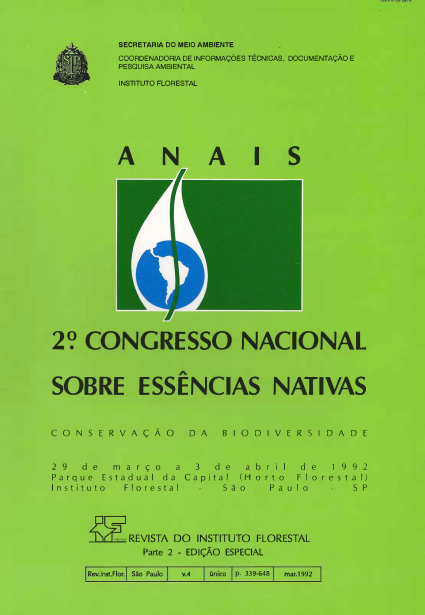RESTAURAÇÃO E MANEJO DE FRAGMENTOS FLORESTAIS
DOI:
https://doi.org/10.24278/2178-5031.199242801Abstract
This paper discusses theoretical and applied aspects of forest fragmentation. It also reports resulte of a case study on the biology and management of plateau forests in the region of Piracicaba, São Paulo. Fores!s fragmentation is a typical phenomenon in practically ali cases of expansion of agricultural frontiers in Brazil. Today, forest fragments house the last remnants of native biodiversity of plateau forests. Studies of forest fragments in the region of Piracicaba indicate that (a) most forest fragments are small and isolated, (b) the occurrence of lianas in high densities is an obstade to natural tree regeneration, (c) the frequency of dead trees is high, (d) edge effects are significant and complex, and (e) forest fragments need management practices in arder to prevent the continuation of current processes of forest degradation and loss of biological biodiversity.
Downloads
References
BERTONI, J. E., 1984. Composição florística e estrutura fitos sociológica de uma flores Ia do interior do eslado de São Paulo. Unicamp.
BURGESS, R. L., & D. M. SHARPE (eds)., 1981. Forest Is/ands Dynamics in Man-dominaled Landscapes. Springer-Verlag, New York.
CAIRNS, J., 1988. Incresing diversity by restoring damaged ecossystems. 333-344 in eds. E. O. WILSON. Biodiversity. National Academy Press, Washington D.C.
CAMARA, I G. & R. A. MITIERMEIER., 1984. Genetic diversity, endemism and protected areas: a case study of the endangered primates of Brazil's Atlantic forest region. 575-580 in eds. J. A. MCNEEL Y and K. R. MILLER. National Parks, Conservation and Development. Smithsonian Institution Press, Washington D.C.
CATHARINO, L. E., 1989. Estudo fisionômico-florístico e fitossociológico de matas residuais no município de Piracicaba ,SP. Unicamp.
CAVASSAN, 0.,1983. Levantamento fitossociológico da vegetação arbórea da Reserva Estadual de Beuru, utilizando o método de quadrantes. UNESP.
CESAR., 1988. Composição tloristice, fitossociológica e ciclagem de nutrientes emmata mesófila semidecídua. UNESP.
DEPRN. 1991. Projeto Olho Verde. Secretaria do Meio Ambiente, São Paulo.
FORMAN, R. T. T. & M.GODRON., 1986. Landscape Ecology. John Wiley & Sons, New York.
GRADWOHL, J. AND R. GREEMBERG., 1991. Small Forest Reserves: Making the Best of a Bad Situation. Climatic Change. Kluwer, Netherlands.
HARRIS, L. D., 1984. TheFragmented Forest. University of Chicago Press., Chicago.
HARRIS, L. D., 1988. Edge effects and conservation of biotic diversity. Conservation Biology, 2(4): 330-33.
JANZEN, D., 1988. Management of habitat fragments in tropical dry forest: growth. Ann. Missouri Bot. Gard. 75:105-116
KAGEYAMA, P. Y., C. P. A. CASTRO & A. H. CARPANEZZI., 1989. Implantação de matas ciliares: estratégias para auxiliar a sucessão secundária. 130 143 in eds. L. M. BARBOSA. Simpósio sobre Mala Ciliar. Fundação Cargill, Campinas, SP.
LEWIN, R., 1984. Parks: how big is big enough. Science. 225: 611-612.
MACARTHUR, R. H. & E. O. WILSON., 1967. The Theoryofls/and Biogeography. Princeton Univ. Press, Princeton.
MARTINS, F. 1979. O método de quadrantes e a fitossociologia deUma floresta residual do interior do estado de São Paulo. USP.
PADUA, M. T. J. & A. T. B. QUINTÃO., 1984. A system of national parks and biological reserves in the Brazilian Amazon. 565-571 in eds. M. J. A. and K. R.. MILLER. National Perk s, Conservalion and Development. Smithsonian Institution Press, Washington D.C.
PAGANO, S. N., 1985. Estudoflorístico, fitossociológico e de ciclagem de nutrienles em mata mesófila semidecídua, no município de Rio Claro, SP. UNESP.
VIANA, V. M., 1987. Ecologia de populações florestais colonizadoras e recuperação de áreas degradadas. In: Simpósio Ecossislemas da Cosia Sul e Sudeste Brasileira: Síntese dos Conhecimenlos. Academia de Ciências do Estado de São Paulo. Anais (1) 29-39.
VIANA V. M., 1990. Biologia e 7nanejo de fragmentos de florestas naturais. VI Congresso Florestal Brasileiro. SBSjSBEF, Campos do Jordão, SP.















